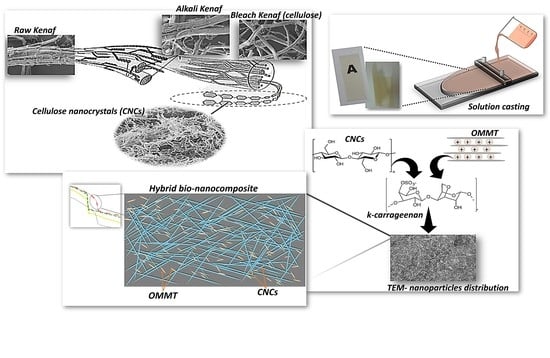Effects of Hybridized Organically Modified Montmorillonite and Cellulose Nanocrystals on Rheological Properties and Thermal Stability of K-Carrageenan Bio-Nanocomposite
Abstract
1. Introduction
2. Materials and Methods
2.1. Reagents and Materials
2.2. Preparation of Cellulose Nanocrystals
2.3. Preparation of Bio-Nanocomposite Films
2.4. Morphological Analysis
2.5. Rheological Analysis
2.6. Thermogravimetric Analysis (TGA)
2.7. Differential Scanning Calorimetry (DSC)
3. Results and Discussion
3.1. Morphological Analysis
3.1.1. Fiber Morphology
3.1.2. Bio-Nanocomposite Morphology
3.2. Rheological Analysis
3.3. Thermogravimetric Analysis
3.4. Differential Thermal Analysis
4. Conclusions
Author Contributions
Funding
Conflicts of Interest
References
- Shojaee-Aliabadi, S.; Mohammadifar, M.A.; Hosseini, H.; Mohammadi, A.; Ghasemlou, M.S.; Hosseinia, M.; Haghshenas, M.; Khaksara, R. Characterization of nanobiocomposite κ-carrageenan film with Zataria multiflora essential oil and nanoclay. Int. J. Biol. Macromol. 2014, 69, 282–289. [Google Scholar] [CrossRef]
- Gonzalez-Gutierrez, J.; Partal, P.; Gallegos, M.; Gallegos., C. Effect of processing on the viscoelastic, tensile and optical properties of albumen/starch-based bioplastics. Carbohydr. Polym. 2011, 84, 308–315. [Google Scholar] [CrossRef]
- Liu, J.; Zhan, X.; Wan, J.; Wang, Y.; Wang, C. Review for carrageenan-based pharmaceutical biomaterials: Favourable physical features versus adverse biological effects. Carbohydr. Polym. 2015, 121, 27–36. [Google Scholar] [CrossRef]
- Tytgata, L.; Vagenendea, M.; Declercqc, H.; Martinsd, J.C.; Thienpontb, H.; Ottevaereb, H.; Dubruela, P.; Van Vlierberghea, S. Synergistic effect of κ-carrageenan and gelatin blends towards adipose tissue engineering. Carbohydr. Polym. 2018, 189, 1–9. [Google Scholar] [CrossRef]
- Rhim, J.W.; Wang, L.F. Mechanical and water barrier properties of agar/κ-carrageenan/konjac/ glucomannan ternary blend biohydrogel films. Carbohydr. Polym. 2013, 96, 71–81. [Google Scholar] [CrossRef]
- Oun, A.A.; Rhim, J.W. Carrageenan-based hydrogels and films: Effect of ZnO and CuO nanoparticles on the physical, mechanical, and antimicrobial properties. Food Hydrocoll 2017, 67, 45–53. [Google Scholar] [CrossRef]
- Tavassoli-Kafrani, E.; Shekarchizadeh, H.; Masoudpour-Behabadi, M. Development of edible films and coatings from alginates and carrageenans. Carbohydr. Polym. 2016, 137, 360–374. [Google Scholar] [CrossRef]
- Wang, Y.; Yuan, C.; Cui, B.; Liu, Y. Influence of cations on texture, compressive elastic modulus, sol-gel transition and freeze-thaw properties of kappa-carrageenan gel. Carbohydr. Polym. 2018, 202, 530–535. [Google Scholar] [CrossRef]
- Wurm, F.; Pham, T.; Bechtold, T. Modelling of phase separation of alginate-carrageenan gels based on rheology. Food Hydrocoll. 2019, 89, 765–772. [Google Scholar] [CrossRef]
- Sapkota, J.; Gooneie, A.; Shirole, A.; Martinez Garcia, J.C. A refined model for the mechanical properties of polymer composites with nanorods having different length distributions. J. Appl. Polym. Sci. 2017, 134, 45279. [Google Scholar] [CrossRef]
- Sapkota, J.; Martinez Garcia, J.C.; Lattuada, M. Reinterpretation of the mechanical reinforcement of polymer nanocomposites reinforced with cellulose nanorods. J. Appl. Polym. Sci. 2017, 134, 45254. [Google Scholar] [CrossRef]
- Trache, D.; Hussin, M.H.; Haafiz, M.K.M.; Thakur, V.K. Recentprogressincellulose nanocrystals: Sources and production. Nanoscale 2017, 9, 1763–1786. [Google Scholar] [CrossRef] [PubMed]
- Li, Y.; Liu, Y.; Chen, W.; Wang, Q.; Liu, Y.; Li, J.; Yu, H. Facile extraction of cellulose nanocrystals from wood using ethanol and peroxide solvothermal pretreatment followed by ultrasonic nanofibrillation. Green Chem. 2016, 18, 1010–1018. [Google Scholar] [CrossRef]
- El Miri, N.; Abdelouahdi, K.; Barakat, A.; Zahouily, M.; Fihri, A.; Solhy, A.; El Achaby, M. Bio-nanocomposite films reinforced with cellulose nanocrystals: Rheology of film-forming solutions, transparency, water vapor barrier and tensile properties of films. Carbohydr. Polym. 2015, 129, 156–167. [Google Scholar] [CrossRef]
- Abdollahi, M.; Alboofetileh, M.; Rezaei, M.; Behrooz, R. Comparing physico-mechanical and thermal properties of alginate nanocomposite films reinforced with organic and/or inorganic nanofillers. Food Hydrocoll. 2013, 32, 416–424. [Google Scholar] [CrossRef]
- Wang, L.-F.; Shankar, S.; Rhim, J.-W. Properties of alginate-based films reinforced with cellulose fibers and cellulose nanowhiskers isolated from mulberry pulp. Food Hydrocoll. 2017, 63, 201–208. [Google Scholar] [CrossRef]
- Fatyeyeva, K.; Chappey, C.; Marais, S. Biopolymer/clay nanocomposites as the high barrier packaging material: Recent advances. In Food Packaging; Academic Press: Cambridge, MA, USA, 2017; pp. 425–463. [Google Scholar]
- Viseras, C.; Aguzzi, C.; Cerezo, P.; Bedmar, M.C. Biopolymer–clay nanocomposites for controlled drug delivery. Mater. Sci. Technol. 2008, 24, 1020–1026. [Google Scholar] [CrossRef]
- Qin, Y.; Wang, W.; Zhang, H.; Dai, Y.; Hou, H.; Dong, H. Effects of Organic Modification of Montmorillonite on the Properties of Hydroxypropyl Di-Starch Phosphate Films Prepared by Extrusion Blowing. Materials 2018, 11, 1064. [Google Scholar] [CrossRef]
- Chivrac, F.; Pollet, E.; Avérous, L. Progress in nano-biocomposites based on polysaccharides and nanoclays. Mater. Sci. Eng. R Rep. 2009, 67, 1–17. [Google Scholar] [CrossRef]
- Yufei, C.; Yang, H.; Qiwang, D.; Xiwang, Z.; Zhang, Q. Preparation and properties of OMMT/PU composites. Adv. Mater. Sci. Eng. 2015, 715879. [Google Scholar] [CrossRef]
- Luo, Y.; Liu, H.Y.; Zhang, G.Z.; Qu, J.P. Morphological and thermal properties of PLA/OMMT. nanocomposites prepared via vane extruder. IOP Conf. Ser. Mater. Sci. Eng. 2017, 213, 012018. [Google Scholar] [CrossRef]
- Zakuwan, S.Z.; Ahmad, I. Synergistic effect of hybridized cellulose nanocrystals and organically modified montmorillonite on κ-Carrageenan bionanocomposites. Nanomaterials 2018, 8, 874. [Google Scholar] [CrossRef] [PubMed]
- Kargarzadeh, H.; Johar, N.; Ahmad, I. Starch biocomposite film reinforced by multiscale rice husk fiber. Compos. Sci. Technol. 2017, 151, 147–155. [Google Scholar] [CrossRef]
- Zafar, R.; Zia, K.M.; Tabasum, S.; Jabeen, F.; Noreen, A.; Zuber, M. Polysaccharide based bionanocomposites, properties and application: A review. Int. J. Biol. Macromol. 2016, 92, 1–13. [Google Scholar] [CrossRef]
- Zubov, A.; Sin, G. Multiscale modeling of poly (lactic acid) production: From reaction conditions to rheology of polymer melt. Chem. Eng. J. 2018, 336, 361–375. [Google Scholar] [CrossRef]
- Noranizan, I.A.; Ahmad, I. Effects of fiber loading and compatibilizer on rheological, mechanical and morphology behaviors. Open J. Polym Chem. 2012, 2, 31–41. [Google Scholar] [CrossRef]
- Troedec, M.L.; Sedan, D.; Peyrotout, C.; Bonnet, J.P.; Smith, A.; Guinebretiere, R.; Gloaguen, V.; Krausz, P. Influence of various chemical treatments on the composition and structure of hemp fibers. Compos. Part A Appl. Sci. Manuf. 2008, 39, 514–522. [Google Scholar] [CrossRef]
- Kim, J.S.; Lee, Y.Y.; Kim, T.H. A review on alkaline pretreatment technology for bioconversion of lignocellulosic biomass. Bioresour. Technol. 2016, 199, 42–48. [Google Scholar] [CrossRef]
- El-Shekeil, Y.A.; Sapuan, S.M.; Khalina, A.; Zainuddin, M.; Al-Shuja’a, E.S.O. Influence of chemical treatment on the tensile properties of jenaf fiber reinforced thermoplastic polyurethane composite. Express Polym. Lett. 2012, 6, 1032–1040. [Google Scholar] [CrossRef]
- El Achaby, M.; Kassab, Z.; Barakat, A.; Aboulkas, A. Alfa fibers as viable sustainable source for cellulose nanocrystals extraction: Application for improving the tensile properties of biopolymer nanocomposite films. Ind. Crop. Prod. 2018, 112, 499–510. [Google Scholar] [CrossRef]
- Kargarzadeh, H.; Sheltami, R.M.; Ahmad, I.; Abdullah, I.; Dufresne, A. Cellulose nanocrystal reinforced liquid natural rubber toughened unsaturated polyester: Effects of filler content and surface treatment on its morphological, thermal, mechanical, and viscoelastic properties. Polymer 2015, 71, 51–59. [Google Scholar] [CrossRef]
- Mariano, M.; Cercená, R.; Soldi, V. Thermal characterization of cellulose nanocrystals isolated from sisal fibers using acid hydrolysis. Ind. Crop. Prod. 2016, 94, 454–462. [Google Scholar] [CrossRef]
- Johar, N.; Ahmad, I. Morphological, thermal, and mechanical properties of starch biocomposite films reinforced by cellulose nanocrystals from rice husks. BioResources 2012, 7, 5469–5477. [Google Scholar] [CrossRef]
- Zainuddin, S.Y.Z.; Ahmad, I.; Kargarzadeh, H. Cassava starch biocomposites reinforced with cellulose nanocrystals from kenaf fibers. Compos. Interface 2013, 20, 189–199. [Google Scholar] [CrossRef]
- Li, J.; Cha, R.; Mou, K.; Zhao, X.; Long, K.; Luo, H.; Zhou, F.; Jiang, X. Nanocellulose-based antibacterial materials. Adv. Healthc. Mater. 2018, 7, 1800334. [Google Scholar] [CrossRef]
- Netoa, W.P.F.; Silverio, H.A.; Dantas, N.O.; Pasquini, D. Extraction and characteristion of cellulose nanocrystals from agro-industrial residue- Soy hulls. Ind. Crop. Prod. 2013, 42, 480–488. [Google Scholar] [CrossRef]
- Indicula, M.; Malhotra, S.K.; Joseph, K.; Thomas, S. Dynamic mechanical analysis of randomly oriented intimately mixed short banana/sisal hybrid fiber reinforced polyester composites. Compos. Sci. Technol. 2005, 65, 1077–1087. [Google Scholar] [CrossRef]
- Pan, M.Z.; Zhang, S.Y.; Zhou, D.G. Preparation and properties of wheat straw fiber-polypropylene composites. Part II. Investigation of surface treatments on the thermo-mechanical and rheological properties of the composites. J. Compos. Mater. 2010, 44, 1061–1074. [Google Scholar]
- Tabatabaei, S.H.; Carreau, P.J.; Ajji, A. Rheological and Thermal Properties of Blends of a Long-Chain Branched Polypropylene and Different Linear Polypropylenes. Chem. Eng. Sci. 2009, 64, 4719–4731. [Google Scholar] [CrossRef]
- Zhou, C.; Wang, Q.; Wu, Q. UV-initiated crosslinking of electrospun poly (ethyleneoxide) nanofibers with pentaerythritoltriacrylate: Effect of irradiation time and incorporated cellulose nanocrystals. Carbohydr. Polym. 2012, 87, 1779–1786. [Google Scholar] [CrossRef]
- Zarina, S.; Ahmad, I. Biodegradable Composite films based on κ-carrageenan reinforced by cellulose nanocrystals form kenaf fibers. BioResources 2015, 10, 256–271. [Google Scholar]
- Martins, J.T.; Cerqueira, M.A.; Bourbon, A.I.; Pinheiro, A.C.; Souza, B.W.S.; Vicente, A.A. Synergistic effects between k-carrageenan and locust bean gum on physicochemical properties of edible films made thereof. Food Hydrocoll. 2012, 29, 280–289. [Google Scholar] [CrossRef]
- Yadav, M.; Chiu, F.-C. Cellulose nanocrystals reinforced k-carrageenan based UV resistant transparent bionanocomposite films for sustainable packaging applications. Carbohydr. Polym. 2019, 211, 181–194. [Google Scholar] [CrossRef] [PubMed]
- Roy, S.; Rhim, J.-W. Preparation of carrageenan-based functional nanocomposite films incorporated with melanin nanoparticles. Coll. Surf. B 2019, 176, 317–324. [Google Scholar] [CrossRef]
- Chen, J.; Chen, W.; Duan, F.; Tanga, Q.; Li, X.; Zeng, L.; Zhang, J.; Xing, Z.; Dong, Y.; Jia, L.; et al. The synergistic gelation of okra polysaccharides with kappa-carrageenan and its influence on gel rheology, texture behaviour and microstructures. Food Hydrocoll. 2019, 87, 425–435. [Google Scholar] [CrossRef]
- Abdorreza, M.N.; Cheng, L.H.; Karim, A.A. Effects of plasticizers on thermal properties and heat seability of sago starch films. Food Hydrocoll. 2011, 25, 56–60. [Google Scholar] [CrossRef]
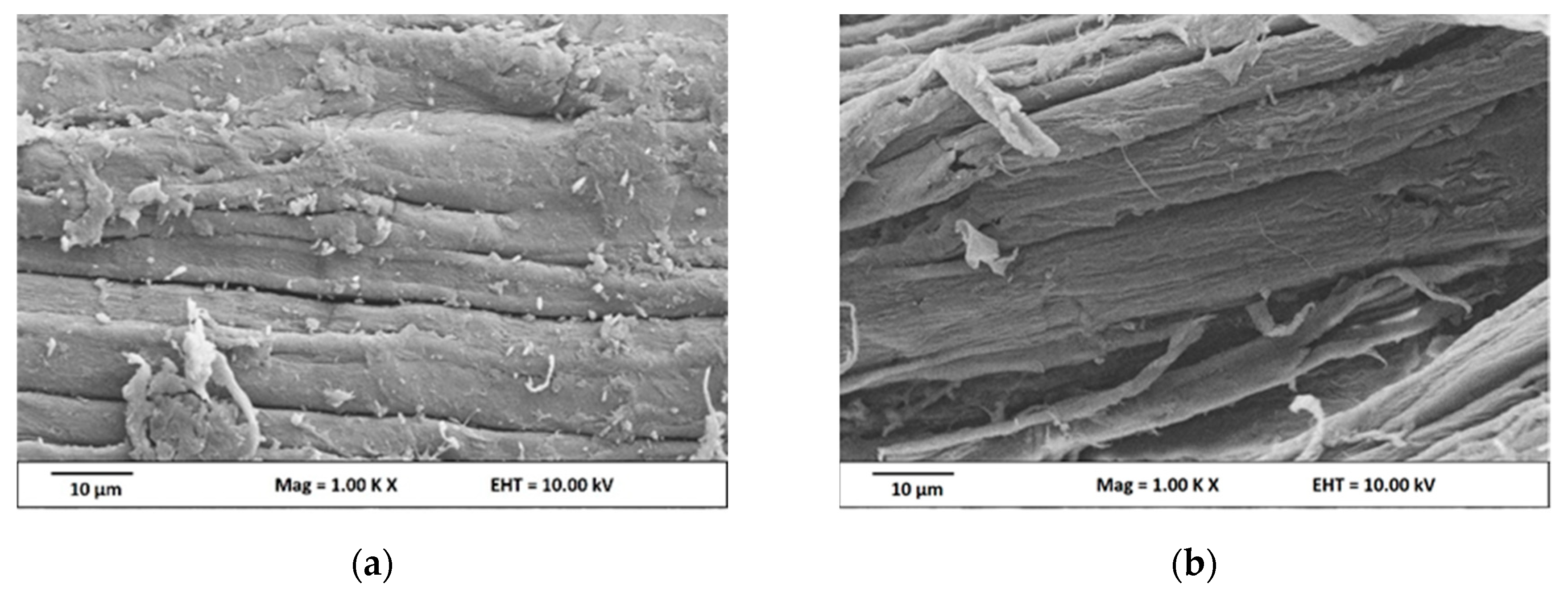
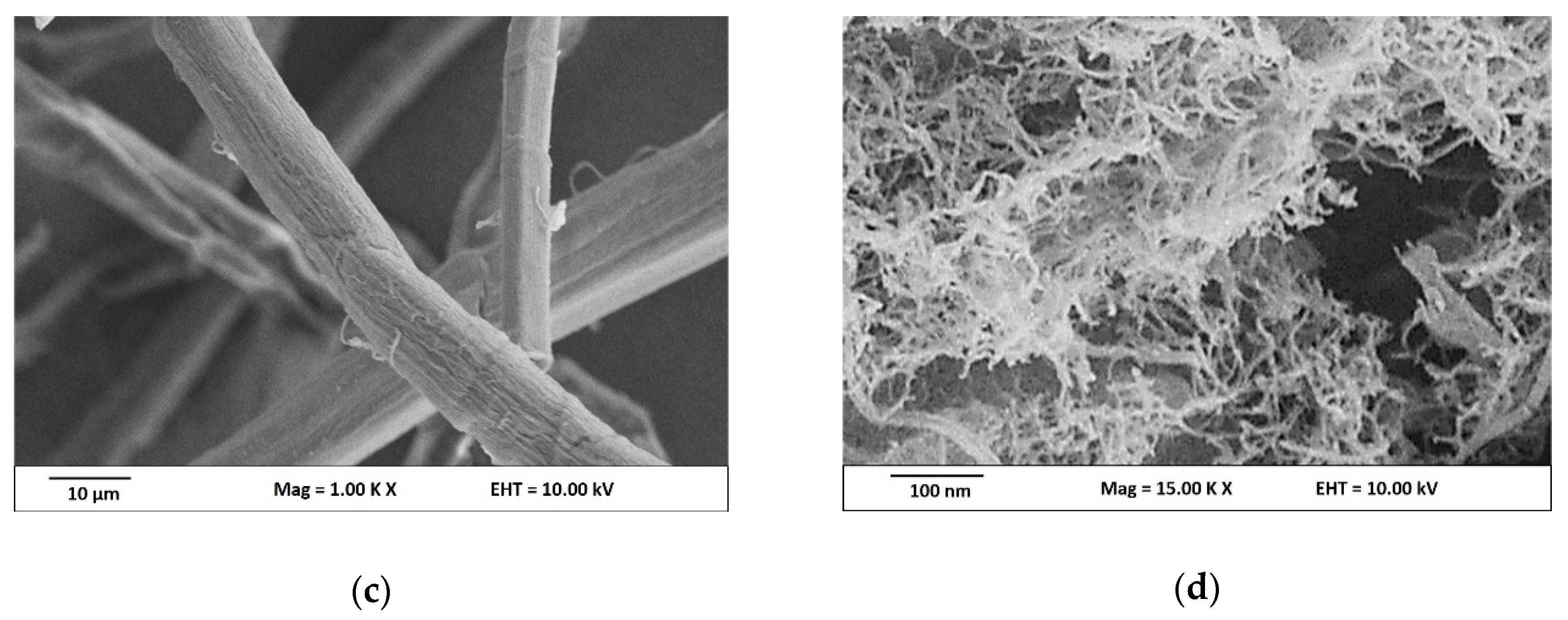
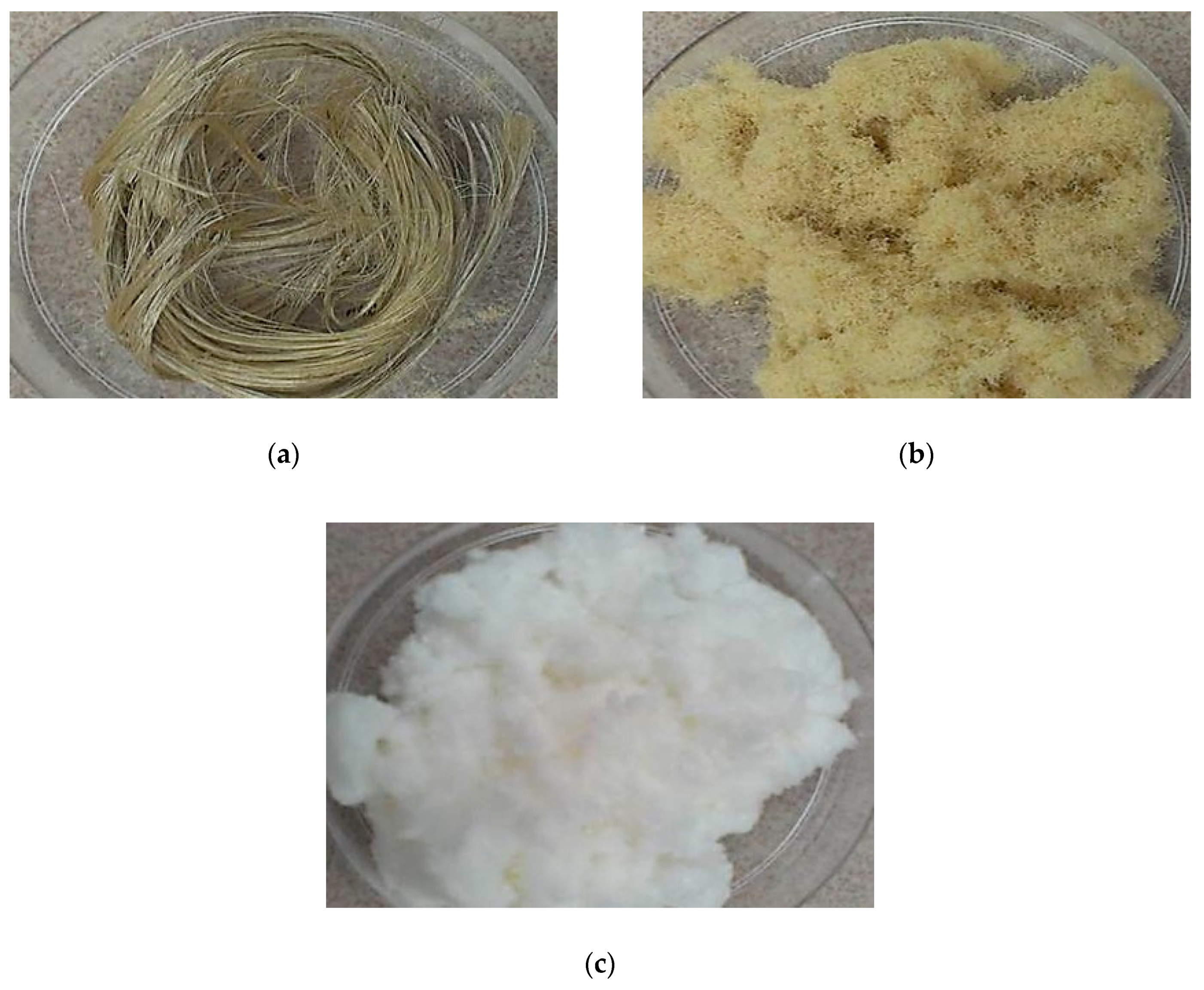
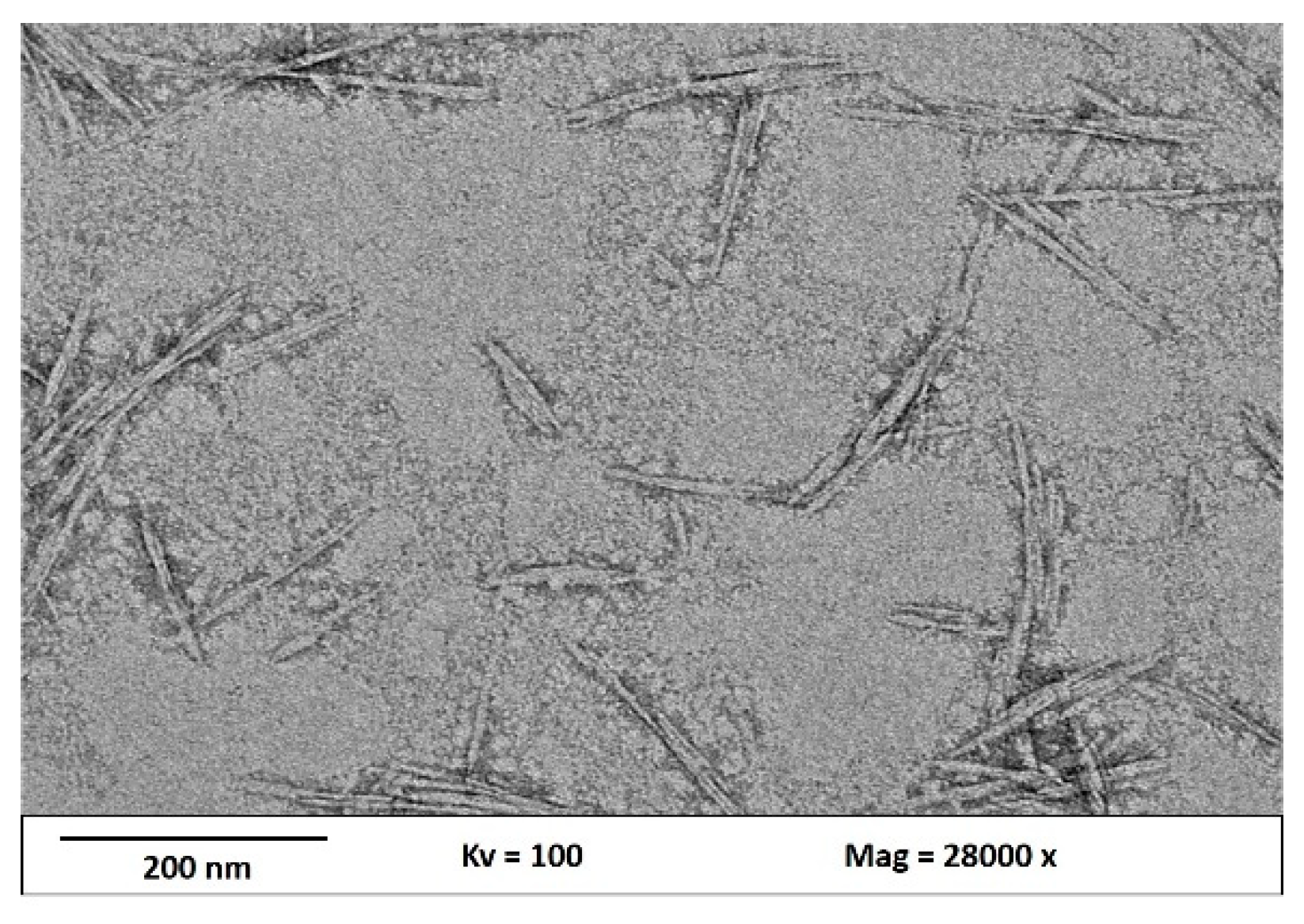

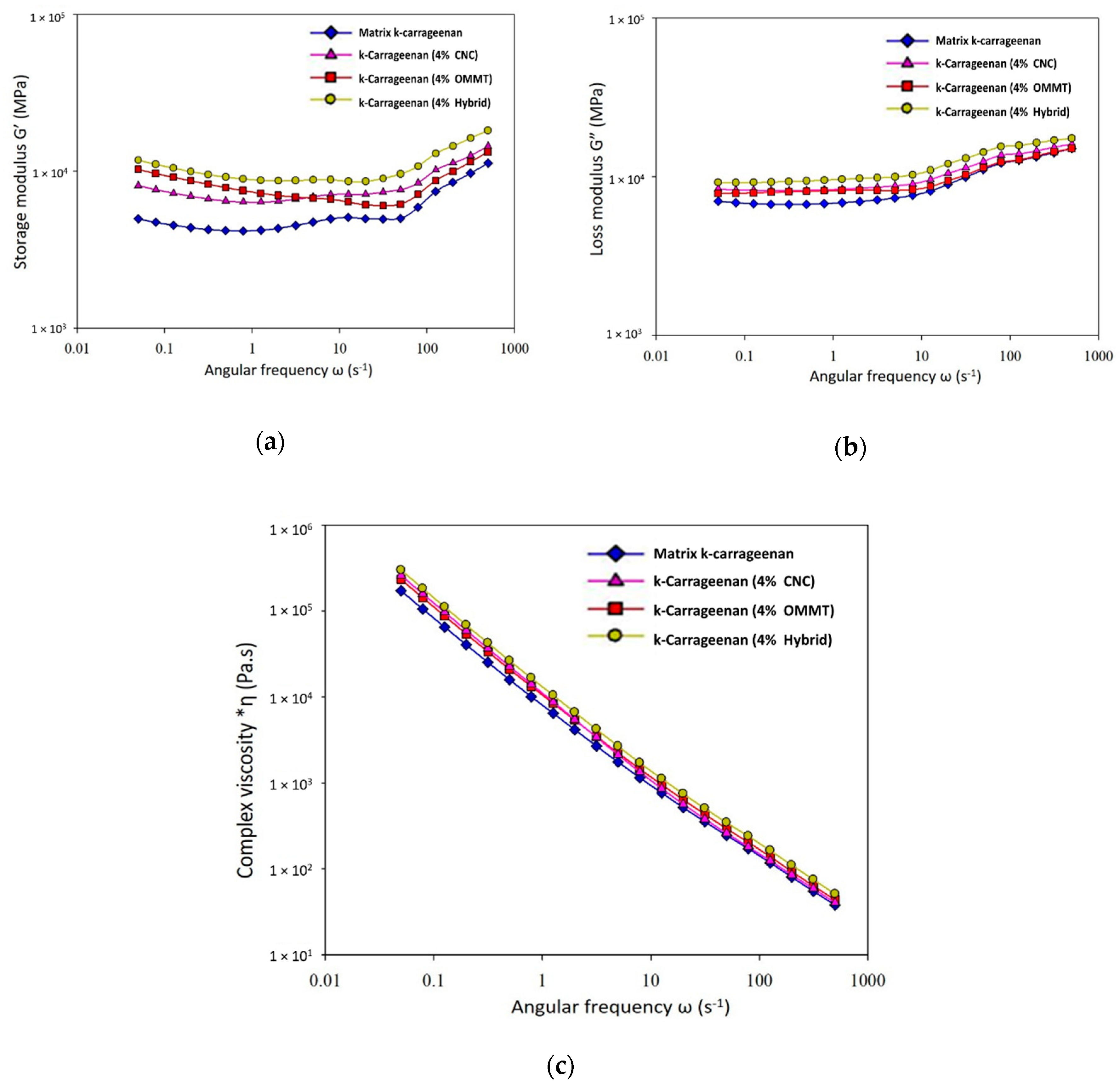
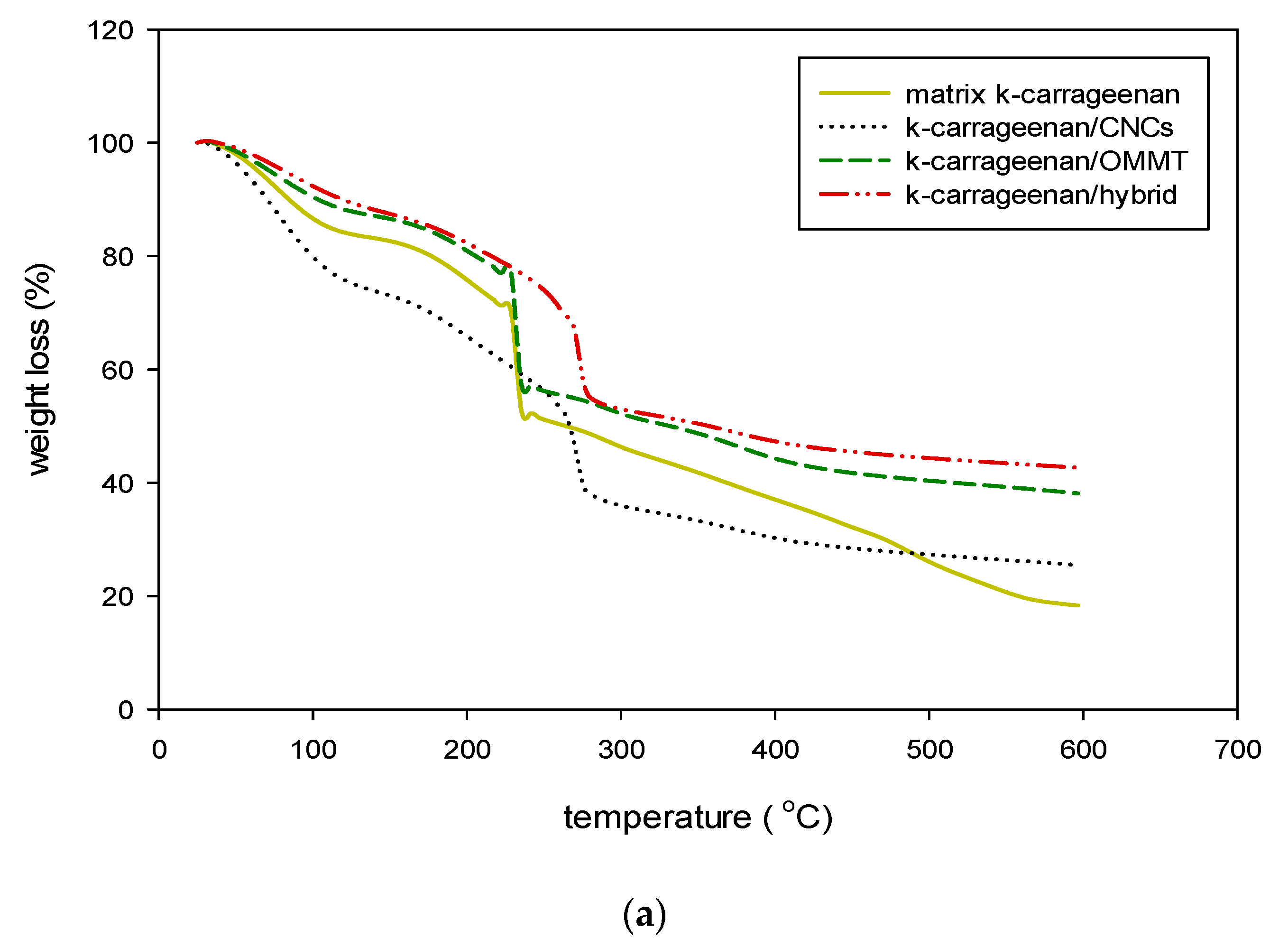
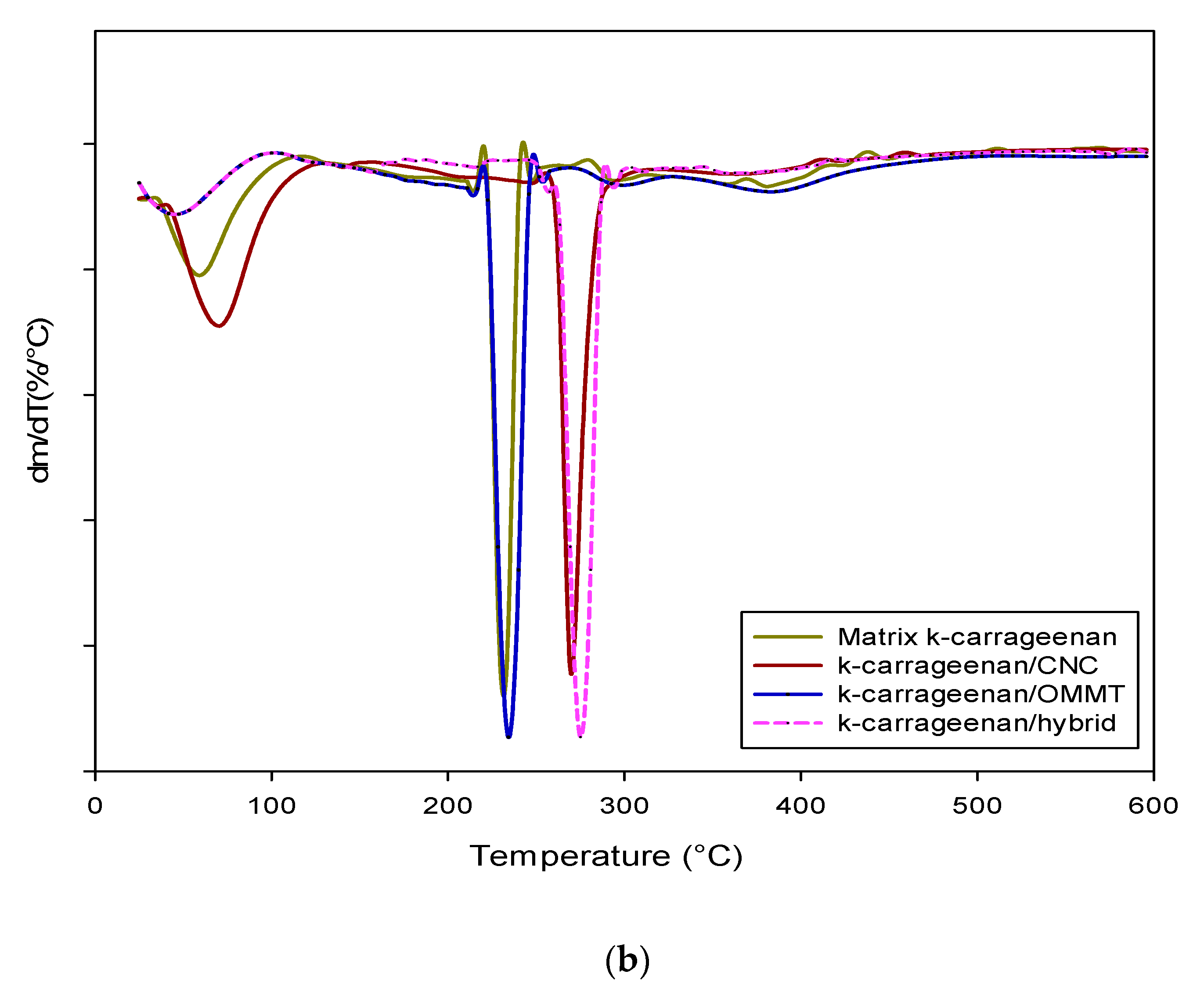
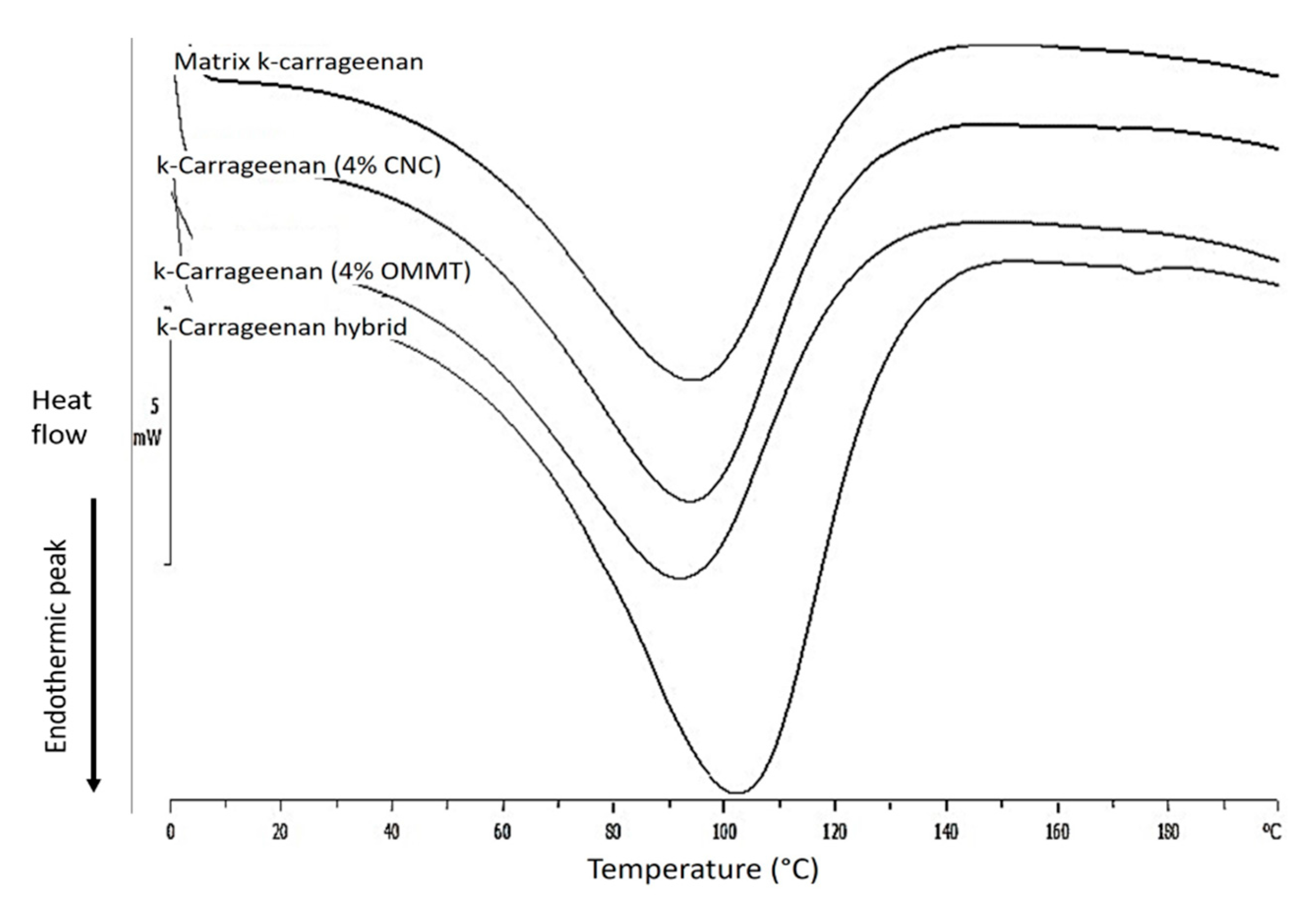
| Sample | Fiber Diameter |
|---|---|
| Raw kenaf | >100 μm |
| Alkali-treated kenaf | 20–90 μm |
| Bleach-treated kenaf | 10–14 μm |
| Hydrolyzed kenaf (CNC) | 12–15 nm |
| Sample | Onset (°C) | Peak (°C) | Endset (°C) | Residue (%) |
|---|---|---|---|---|
| k-carrageenan matrix | 228 | 230 | 236 | 18.32% |
| k-carrageenan (4% CNCs) | 264 | 270 | 278 | 25.49% |
| k-carrageenan (4% OMMT) | 227 | 233 | 236 | 38.11% |
| k-Carrageenan (hybrid) | 268 | 275 | 284 | 42.65% |
| Sample | Onset (°C) | Peak (°C) | Endset (°C) | Integral (mJ) |
|---|---|---|---|---|
| k-Carrageenan matrix | 59.34 | 94.67 | 123.38 | −1440.93 |
| k-Carrageenan (4% CNCs) | 54.98 | 94.50 | 120.86 | −1445.04 |
| k-Carrageenan (4% OMMT) | 54.00 | 93.67 | 115.48 | −1337.71 |
| k-Carrageenan (hybrid) | 64.80 | 103.00 | 129.29 | −2177.67 |
© 2019 by the authors. Licensee MDPI, Basel, Switzerland. This article is an open access article distributed under the terms and conditions of the Creative Commons Attribution (CC BY) license (http://creativecommons.org/licenses/by/4.0/).
Share and Cite
Zakuwan, S.Z.; Ahmad, I. Effects of Hybridized Organically Modified Montmorillonite and Cellulose Nanocrystals on Rheological Properties and Thermal Stability of K-Carrageenan Bio-Nanocomposite. Nanomaterials 2019, 9, 1547. https://doi.org/10.3390/nano9111547
Zakuwan SZ, Ahmad I. Effects of Hybridized Organically Modified Montmorillonite and Cellulose Nanocrystals on Rheological Properties and Thermal Stability of K-Carrageenan Bio-Nanocomposite. Nanomaterials. 2019; 9(11):1547. https://doi.org/10.3390/nano9111547
Chicago/Turabian StyleZakuwan, Siti Zarina, and Ishak Ahmad. 2019. "Effects of Hybridized Organically Modified Montmorillonite and Cellulose Nanocrystals on Rheological Properties and Thermal Stability of K-Carrageenan Bio-Nanocomposite" Nanomaterials 9, no. 11: 1547. https://doi.org/10.3390/nano9111547
APA StyleZakuwan, S. Z., & Ahmad, I. (2019). Effects of Hybridized Organically Modified Montmorillonite and Cellulose Nanocrystals on Rheological Properties and Thermal Stability of K-Carrageenan Bio-Nanocomposite. Nanomaterials, 9(11), 1547. https://doi.org/10.3390/nano9111547



